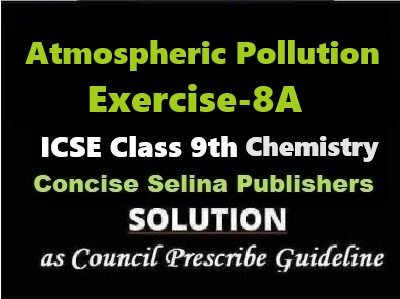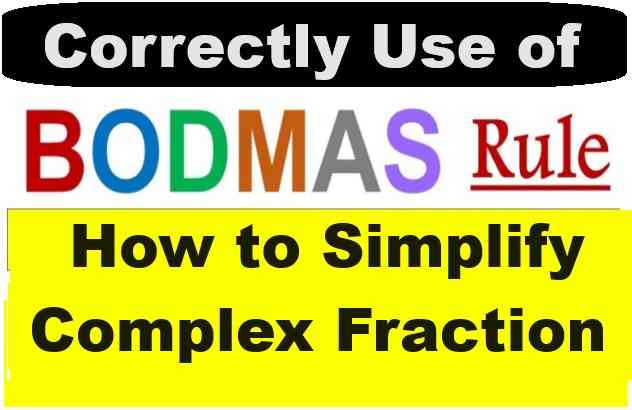Atmospheric Pollution Exe-8A Chemistry Class-9 ICSE Selina Publishers Solutions Chapter-8. Step By Step ICSE Selina Concise Solutions of Chapter-8 Atmospheric Pollution with All Exercise including MCQs, Very Short Answer Type, Short Answer Type, Long Answer Type, Numerical and Structured/Application Questions Solved . Visit official Website CISCE for detail information about ICSE Board Class-9.
Atmospheric Pollution Exe-8A Chemistry Class-9 ICSE Concise Selina Publishers
| Board | ICSE |
| Publications | Selina Publication |
| Subject | Chemistry |
| Class | 9th |
| Chapter-8 | Atmospheric Pollution |
| Book Name | Concise |
| Topics | Solution of Exercise – 8A |
| Academic Session | 2023-2024 |
A. Exercise – 8A
Atmospheric Pollution Class-9 Chemistry Concise Solutions
Page-138
Question 1.
Define the following terms:
(i) pollution
(ii) pollutant
(iii) air pollution
Answer:
(i) Pollution :- Pollution may be defined as contamination of air, water or soil by undesirable amounts of materials or heat and is caused by the concentration of substances which have harmful effects.
(ii) Pollutant :- Toxic and otherwise harmful substances which have an undesirable impact on different components of the environment and life forms are known as pollutants.
(iii) air pollution :- Air pollution means degradation of air quality due to concentration of harmful contaminants which affect human, plant and animal lives.
Question 2.
Name any four gaseous pollutants.
Answer:
Sulphur dioxide, hydrogen sulphide, carbon monoxide and hydrocarbons.
Question 3.
Name the compounds of sulphur that cause air pollution. Also state the harmful effects of sulphur compounds.
Answer:
Compounds of sulphur like sulphur dioxide, sulphur trioxide and hydrogen sulphide are pollutants.
Harmful effects of oxides of sulphur:
(a) It causes headache, vomiting and even death due to respiratory failure.
(b)and It destroys vegetation and weakens building materials/constructions.
(c)mixes with smoke and fog to form smog, which is very harmful.
It is oxidised by atmospheric oxygen into sulphur trioxide (SO3) which combines with water to form sulphuric acid.
2SO2(g) + O2(g) →2SO3(g)
SO3(g) + H2O(l) → H2SO4(l)
Question 4.
State:
(i) natural sources of air pollution
(ii) man-made sources of air pollution
Answer:
(i) natural sources of air pollution are:-Volcanoes, decaying vegetation, forest fires and dust storms
(ii) man-made sources of air pollution:-Automobiles, factories, industrial processes and decay of crop residue in rural areas
Question 5.
(a) How do oxides of nitrogen enter the atmosphere?
(b) What are their harmful effects?
Answer:
(a) oxides of nitrogen enter the atmosphere
- Oxides of nitrogen, nitric oxide (NO) and nitrogen dioxide (NO2), enter the atmosphere in the following ways:
- On burning of fuels in furnaces, the temperature increases. At high temperature, nitrogen and oxygen present in the air combine to form oxides of nitrogen.
- Oxides of nitrogen are produced during the burning of fuel in an internal combustion engine. They enter the atmosphere as exhaust gases.
- During thunderstorms, nitric oxide is formed by the reaction between atmospheric nitrogen and oxygen in the presence of electric discharge.
- Nitric oxide further reacts with atmospheric oxygen and ozone to form nitrogen dioxide.
(b) Harmful effects of the oxide of nitrogen:
Nitrogen dioxide is very harmful to plants and animals.
- It causes irritation in the mucous membrane.
- Large concentrations of NO2 may cause serious lung diseases.
- Nitrogen dioxide causes serious injury to vegetation; it damages plant leaves.
- In sunlight, nitrogen dioxide oxidises hydrocarbons to form photochemical smog. Photochemical smog causes eye irritation, asthma attacks and nasal and throat infections.
Question 6.
State the origin and health impact of smog.
Answer:
Smog is a dark, thick, dust and soot-laden fog pollutant which is a combination of oxides of nitrogen and sulphur and of partially oxidisedhydrocarbons and their derivatives produced by industries and automobiles.
Smog is noxious and irritating. It reduces visibility, induces respiratory troubles and can cause death by suffocation.
Question 7.
What are the harmful effects of oxides of sulphur?
Answer:
Harmful effects of oxides of sulphur:
(a) It causes headache, vomiting and even death due to respiratory failure.
(b) It destroys vegetation and weakens building materials/constructions.
(c) It mixes with smoke and fog to form smog, which is very harmful.
It is oxidised by atmospheric oxygen into sulphur trioxide (SO3) which combines with water to form sulphuric acid.
2SO2(g) + O2(g) →2SO3(g)
SO3(g) + H2O(l) → H2SO4(l)
Question 8.
State the main sources and effects of carbon monoxide.
Answer:
Carbon monoxide is formed by incomplete combustion of fuels in homes, factories and automobiles.
Effects of carbon monoxide are as follows:
- It is a highly poisonous gas.
- It reduces the oxygen-carrying capacity of blood by an amount equivalent to the amount of haemoglobin converted to carboxyhaemoglobin.
Haemoglobin + CO → Carboxyhaemoglobin - Because heart and brain are the two tissues most sensitive to oxygen depletion, they show the most serious effects of carbon monoxide exposure.
In high concentrations, carbon monoxide may kill by paralysing normal brain action.
Question 9.
Give the mechanism of the action of carbon monoxide.
Answer:
It is a highly poisonous gas.
When inhaled, it passes through the lungs directly into the blood stream. There it combines with haemoglobin, the substance which carries oxygen to body tissues. Because haemoglobin binds with carbon monoxide 200 times more strongly than oxygen, even low concentrations of carbon monoxide in air have magnified effects on the body.
It reduces the oxygen-carrying capacity of blood by an amount equivalent to the amount of haemoglobin converted to carboxyhaemoglobin.
Haemoglobin + CO → Carboxyhaemoglobin
Question 10.
How can we control carbon monoxide poisoning?
Answer:
Carbon monoxide pollution can be controlled in the following ways:
- By switching over from internal combustion engines to electrically powered cars.
- Many pollution control devices are now installed in cars. Most of these devices help reduce pollution by burning gasoline completely. Complete combustion of gasoline produces only carbon dioxide and water vapour.
2C8H18 + 5O2→ 16CO2 + 18H2O
- By using substitute fuels for gasoline: Natural gas in both compressed (CNG) and liquefied (LNG) forms is now increasingly being used as fuel. Alcohols are other feasible substitutes.
- By using catalytic convertors:
i. Nitrogen oxide is reduced to nitrogen and oxygen in the presence of finely divided platinum or palladium as a catalyst.
2NO → N2 + O2
2NO → N2 + 2O2
- Carbon monoxide changes to carbon dioxide in the presence of finely divided platinum as catalyst.
CO → CO2 + H2O
— : End of Atmospheric Pollution Exe-8A Answer Class-9 ICSE Chemistry Solutions :–
Return to Return to Concise Selina ICSE Chemistry Class-9
Thanks
Please share with your friends




